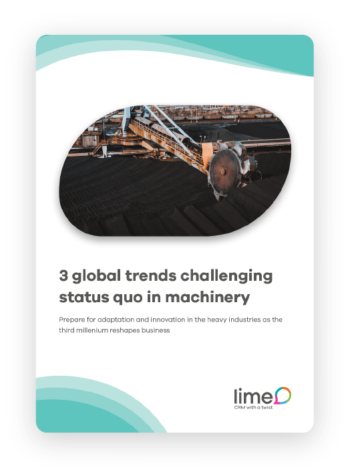3 ways to better business as third millennium pressures machinery

Recognizing something needs to be done is one thing. From there, mapping out your options and deciding more specifically what that something should be is ten times harder. In this article, we elaborate on possible routes to meet the new standards of the machinery market. and walk you through pros and cons of alternative investments.
Global trends force change
To start with, industry leaders and experts agree there are mainly three global trends shaping the new competitive landscape for machinery. Sustainability, digitalization, and machine as a service have already disrupted business as usual for multiple machine companies. Pains in your daily operations could most likely be understood as part of this current paradigm shift in the industry, rather than isolated challenges. In other words, it’s not only you and it’s not temporary.
Understanding your options
Now, we are aware of the challenging situation in the industry. Luckily, there are multiple options to future-proof business for leaders who dare to act. A first step is to evaluate what type of pains you suffer from the most, and in which category you should start looking for solutions. Being thorough in this step is well spent time and will help you sort some priorities out before comparing actual functions, costs and suppliers further down the road.
Boost internal competence and optimize workflows
In summary, you could boost your in-house capacity and try to optimize your resources. This could be done by educating your teams and try to bridge departments together to improve collaboration. Further, if you look to scale business, employing more people is probably on the agenda as well.
Pros
- Upgrading workflows could help utilize the resources you already have
- New employment could bring new perspectives and competence
Cons
- Hard to follow-up and maintain new routines over time
- Recruiting is an expensive and time-consuming process.
- Investing exclusively in human competence is a vulnerable strategy
Outsource parts of the business
As the modern customer expects around-the-clock service, expert support, and life-cycle maintenance of their products, outsourcing parts of the business may be a solution. It is not a completely new phenomenon, however as the complexity of business escalates, so does the outsourcing process.
Pros
- A quick solution compared to building up the functions inhouse
- Could offer new business opportunities and boost resilience to market fluctuations
Cons
- Hard to ensure quality in all steps throughout the value-chain
- Friction and extra workload in coordinating all parties
- Decreased agility following dependency on your external actors
A client to us wanted to offer on-site maintenance to their customers since many of their competitors started to do so. They wanted to get up and running fast, so they decided to outsource this function via an external service partner. At the beginning, things went very well, and the company soon let more and more time elapse between follow-ups. About a year later, they suddenly saw an increase of complaints from customers whose equipment had broken down. This could be traced back to falsely installed spare parts and lack of know-how in maintenance of the equipment. They instantly cancelled the partnership, but they had to inspect all the customers’ equipment to understand how extensive the damage was. This illustrates the potential risk when outsourcing slips out of control. Companies must evaluate what tools and procedures they need, to ensure a sustainable collaboration with external parties.

Invest in IT
Despite being an innovative industry throughout the history, the level of digital maturity among machine companies has failed to follow the pace of digitalization in the civil society. On the positive side, machine companies still have loads of potential to unlock. Implementing modern IT is a concrete action to take control of your data, procedures, and resources.
Pros
- Long-term impact
- Customers will experience better access to your services
- An IT foundation is the first step to automate processes and improve efficiency
- Could solve multiple challenges
- Less dependency on individuals, less vulnerability
- Help maintain the workflows you aim to have
- Organize and evaluate activities and investments
Cons
- Hard to select what tools best fit your needs
- Takes effort and behavioral change to be successful
- Risk to alienate personnel who doesn’t feel comfortable going digital
According to research, there are more Saas-companies than ever, and the amount just keeps on growing. One of the risks when implementing an IT-solution is ensuring that the users use the system. Looking for new IT may therefore be a both challenging and interesting experience, as today there is no trouble finding powerful tools to target your industry specific needs.
Read more:
Summary
Inevitably, every path towards change comes with a set of pros and cons. Maybe you have initiated some already, but still struggle to see the results you’d hoped for. A common reason machine companies fail to follow through on their investments is that they underestimate the importance of supporting tools. Future-proofing business is a puzzle of short-and long-term actions, but don’t let your investments go to waste due to insufficient IT. To meet the global challenges of the industry, you need to go digital sooner rather than later – probably combined with updating workflows and hiring new competence.
Want to learn more? Explore our report about 3 trends challenging status quo in machinery

What are you waiting for?
There’s no time to waste! Let’s find the solution that will help you get more customers and turn existing ones into loyal ambassadors today.